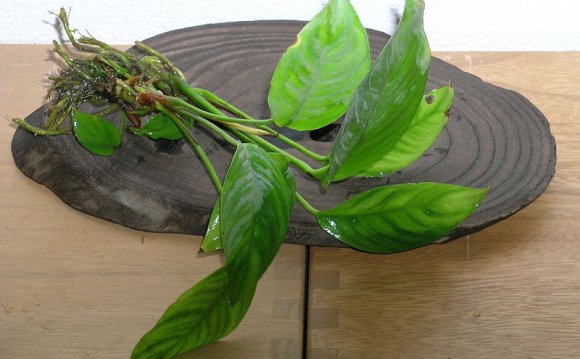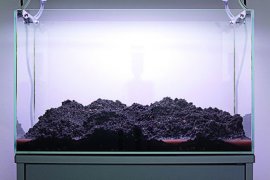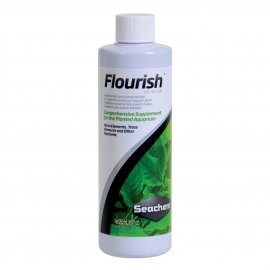
 The lush alluring appearance of a naturally planted tank is as aesthetically stunning as it is beneficial for fish. Perhaps it is the charm of an aquascaped environment, the numerous benefits fish receive from a natural setting, or the love for nurturing a complete living miniature ecosystem that initially draws fish keepers into the world of naturally planted aquariums. Whatever the cause for the interest in keeping live aquatic plants, one thing is certain: starting a naturally planted aquarium is often viewed as an overwhelming, tedious, process that turns beginners away. It is true that there is much to learn about keeping live plants but the benefits of doing so are not only long-lasting for the owner but also for their fish. In fact, Betta fish benefit significantly from such an environment.
The lush alluring appearance of a naturally planted tank is as aesthetically stunning as it is beneficial for fish. Perhaps it is the charm of an aquascaped environment, the numerous benefits fish receive from a natural setting, or the love for nurturing a complete living miniature ecosystem that initially draws fish keepers into the world of naturally planted aquariums. Whatever the cause for the interest in keeping live aquatic plants, one thing is certain: starting a naturally planted aquarium is often viewed as an overwhelming, tedious, process that turns beginners away. It is true that there is much to learn about keeping live plants but the benefits of doing so are not only long-lasting for the owner but also for their fish. In fact, Betta fish benefit significantly from such an environment.
Naturally planted tanks have strong benefits for long-finned Betta fish in particular. The crude, sharp, plastic faux-plants sold by pet and fish stores damage their delicate fins. Torn, shredded, fins open Betta fish up to all sorts of bacterial infections and there is never a guarantee that fins will heal back exactly the same upon recovery. While fabric plants are more suitable and popular for Betta fish tanks they are also less in variety and number, often harder to find than their plastic counterparts. And while fake fabric plants may be easier to manage and cheaper in the short-term, living plants add so many more benefits to an aquarium that not seriously considering them neglects significant potential for a higher-quality home for your fish.
And while fake fabric plants may be easier to manage and cheaper in the short-term, living plants add so many more benefits to an aquarium that not seriously considering them neglects significant potential for a higher-quality home for your fish.
Live plants may come with their own set of rules for care but they give back immensely. The most important reason why a Betta keeper may consider establishing a naturally planted tank is what one contributes to establishing and maintaining a healthy nitrogen cycle. In the case of naturally planted tanks, the plants become the main filtration system for the tank and the more plants you have the better off your water quality. As has been deeply discussed on this blog, the nitrogen cycle effects every aspect of aquarium keeping and the chemicals present in it are unavoidable, and potentially deadly, to Betta fish regardless of whether or not a fish keeper chooses to complete the cycle. Live plants help remove the harmful invisible chemicals that are always present in an aquatic environment, feeding off them and converting them into less harmful byproducts. High water quality results in a high quality life for Betta fish.
 Not only do a live plants help stabilize and maintain a healthy nitrogen cycle, they also provide a feeling of safety and protection for fish. Betta fish particularly heavy amounts of coverage to feel secure, especially if living with companions. It is often thought that self-harm expressed through tail-biting is a result of stress stemming from too many open spaces. Adding hiding spots and foliage is a common remedy suggested for tail-biters that wields positive results for Betta fish that self-harm due to this particular kind of stress, though it should be noted that the behavior may continue if instigated from other factors. Live plants offer thick, smooth, coverage that Betta fish like to swim through. Additionally, having a variety of live plants will give fish opportunities to explore. Bored bettas may also tail bite but they may also become lethargic due to a lack of stimulation, so the addition of live plants immediately helps improve their lives from three significant standpoints.
Not only do a live plants help stabilize and maintain a healthy nitrogen cycle, they also provide a feeling of safety and protection for fish. Betta fish particularly heavy amounts of coverage to feel secure, especially if living with companions. It is often thought that self-harm expressed through tail-biting is a result of stress stemming from too many open spaces. Adding hiding spots and foliage is a common remedy suggested for tail-biters that wields positive results for Betta fish that self-harm due to this particular kind of stress, though it should be noted that the behavior may continue if instigated from other factors. Live plants offer thick, smooth, coverage that Betta fish like to swim through. Additionally, having a variety of live plants will give fish opportunities to explore. Bored bettas may also tail bite but they may also become lethargic due to a lack of stimulation, so the addition of live plants immediately helps improve their lives from three significant standpoints.
 Starting a naturally planted tank is not something to be done without research, as it is not as simply as picking out substrate, plants, and lighting. Depending on local water, the type of aquarium desired, shape of the aquarium, and budget, the options for naturally planted fish tanks vary greatly. It is important to know what is desired and how to best achieve that desired tank to figure out if it is manageable based on individual circumstances. To do so, consider the following factors.
Starting a naturally planted tank is not something to be done without research, as it is not as simply as picking out substrate, plants, and lighting. Depending on local water, the type of aquarium desired, shape of the aquarium, and budget, the options for naturally planted fish tanks vary greatly. It is important to know what is desired and how to best achieve that desired tank to figure out if it is manageable based on individual circumstances. To do so, consider the following factors.
Water
Water may look the same coming from the tap but without a test kit it is impossible to know what species would do best in an aquarium. Liquid test kits, such as this master kit from API on Amazon are far more reliable and accurate than paper based testing strips. A complete test kit should contain a test for ammonia, nitrite, nitrate, pH, and water hardness. Ammonia, nitrite, and nitrate are the significant players in the water cycle and can be learned about in detail in this previous BettaSmart article. The quick run through is ammonia is present and produced naturally in water through waste, uneaten food, and fish exhale.
The quick run through is ammonia is present and produced naturally in water through waste, uneaten food, and fish exhale.
Ammonia is poisonous to Betta fish at any level and the higher the parts per million (ppm) the more likely burns, poisoning, and death are for fish. Ammonia is eventually eaten by nitrifying bacteria and is converted to the still-poisonous but slightly less dangerous chemical called nitrite. The same process is done to nitrite over a long period of time and the bacteria turn it into the still-poisonous but least harmful chemical called nitrate. Nitrate is okay to have in aquarium waters but only at the ideal level of 20ppm and can only be removed through water changes. Testing for chemicals is crucial for adding live plants because a fully cycled tank must be established before adding live plants and—for the best health benefit—before live fish, though an in-fish cycle is possible.
Next is pH. Betta fish prefer a neutral pH but if local water that they are acclimated to contains slightly more acidic or slightly more basic pH it is best not to try and change it chemically as fish and plants may be harmed as a consequence. Finding live plants that best match the pH of local source water is the best route to go. Learn about what best suits your local water and select from those plants.









